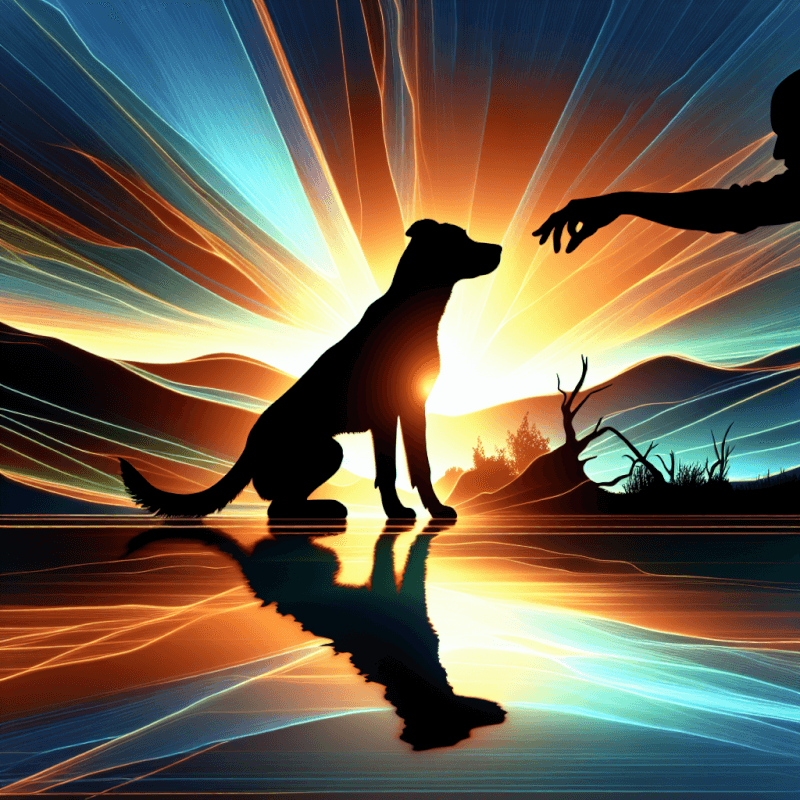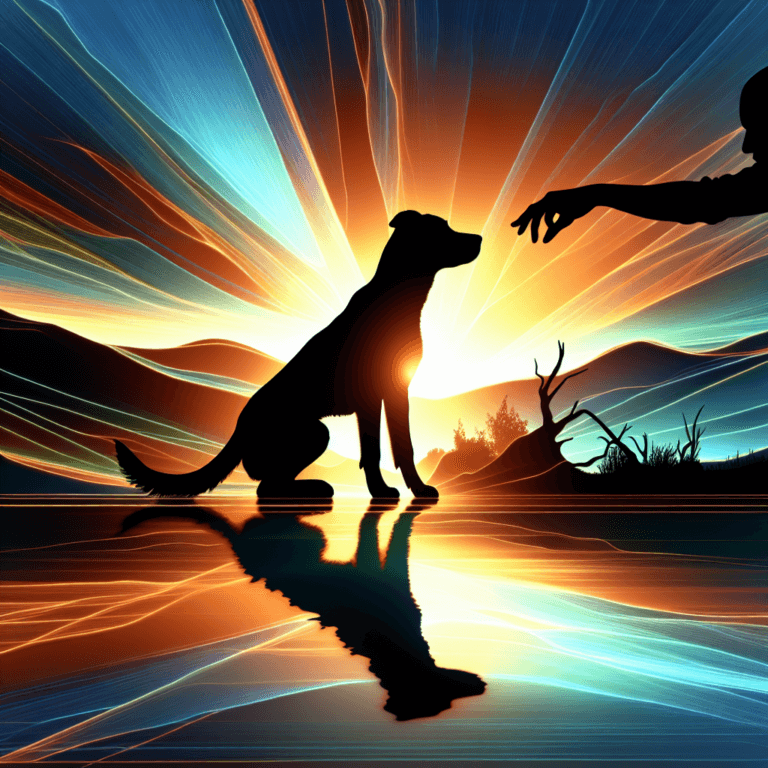If you’ve ever found yourself frustrated by your pup’s reactive behavior, this article is here to lend a helping paw. We all want our furry friends to be well-behaved and happy, and that starts with addressing any reactive tendencies they may have. Whether it’s barking, lunging, or pulling on the leash, understanding the root causes and implementing effective training techniques can make all the difference. So, if you’re ready to transform your dog’s reactive behavior into a calm and composed demeanor, let’s get started!

Understanding Reactive Behavior
Definition of reactive behavior
Reactive behavior in dogs refers to a strong and often unpredictable response to certain stimuli. It can manifest as barking, growling, lunging, or even aggressive behavior. Reactive dogs tend to react defensively or fearfully when faced with triggers such as other dogs, strangers, loud noises, or unfamiliar environments. It is important to recognize that reactive behavior is a natural response and should not be confused with aggression. Reactive dogs may act out due to fear, anxiety, or a lack of proper socialization.
Ready for Cat Trivia?
Test your knowledge about cats!

Causes of reactive behavior
Reactive behavior in dogs can have various underlying causes. One of the main reasons is a lack of proper socialization during the critical developmental stages of a dog’s life. If a dog wasn’t exposed to different people, animals, and environments at a young age, they may be more likely to develop reactive behavior. Other factors such as genetics, past traumatic experiences, fear, and anxiety can also contribute to reactive behavior.
Common signs of reactive behavior
It is important to be able to recognize the signs of reactive behavior in order to address it effectively. Some common signs include excessive barking, growling, lunging, pulling on the leash, raised hackles, showing teeth, or freezing in place. The body language of a reactive dog may also demonstrate signs of stress or discomfort, such as a tense posture, dilated pupils, or a tucked tail. Understanding these signs allows us to intervene and manage reactive behavior more effectively.
Importance of Training Reactive Dogs
Creating a safer environment
Training reactive dogs is crucial for creating a safer environment for both the dog and those around them. By addressing reactive behavior, we can prevent potential incidents and ensure the well-being of everyone involved. A well-trained reactive dog is less likely to pose a risk to other dogs, animals, or people they encounter. This not only promotes the safety of the community but also helps to alleviate the stress and anxiety that reactive dogs may experience when faced with triggering situations.
Improving the dog’s quality of life
Training reactive dogs can significantly improve their overall quality of life. Reactive behavior often stems from fear, anxiety, or a lack of understanding of how to cope with certain situations. By teaching them alternative behaviors, we can help them feel more confident, relaxed, and secure in their environment. A reactive dog who has been properly trained and socialized can enjoy a wider range of experiences, have more fulfilling interactions with other dogs and people, and ultimately lead a happier and more balanced life.
Enhancing the bond between dog and owner
Training a reactive dog requires time, effort, and patience, but it can also strengthen the bond between dog and owner. The training process involves clear communication, consistency, and positive reinforcement, all of which build trust and understanding between the two. By working together to overcome reactive behavior, the dog and owner establish a deeper connection and develop a mutual sense of respect and cooperation. The training journey can be a transformative experience for both, fostering a positive relationship based on trust, empathy, and support.
Positive Reinforcement Training
The concept of positive reinforcement
Positive reinforcement training is a highly effective and humane approach to dog training that focuses on rewarding desired behaviors rather than punishing or correcting unwanted behaviors. It involves using rewards such as treats, praise, or play to reinforce behaviors that we want the dog to repeat. By rewarding the dog for displaying desired behaviors, we encourage them to make positive associations and choices. Positive reinforcement training encourages a dog to think and learn, strengthening their bond with their owner and fostering a positive and motivated attitude towards training.
Benefits of positive reinforcement
Positive reinforcement training has numerous benefits for reactive dogs. Firstly, it creates a positive and enjoyable training experience for both the dog and the owner, reducing stress and making the learning process more effective. Additionally, positive reinforcement helps to build confidence and trust in the dog, as they learn that their actions lead to rewards and praise. This positive association translates into more focused and cooperative behavior, making it easier to address reactive behavior and redirect it towards more desirable alternatives.
Applying positive reinforcement in reactive dog training
When training reactive dogs, positive reinforcement should be the foundation of the training approach. Instead of punishing or scolding the dog for reactive behavior, the focus should be on rewarding calm and non-reactive behavior. For example, when a reactive dog remains calm in the presence of a trigger, they should be rewarded with treats, praise, or play. By consistently rewarding calm behavior, the dog learns that staying calm leads to positive outcomes, which helps to reduce reactive responses over time. It is essential to remember that patience and consistency are key when applying positive reinforcement in reactive dog training.
Identifying Triggers
Understanding what triggers reactive behavior
In order to effectively address reactive behavior, it is important to identify the triggers that provoke such responses in dogs. Triggers can be anything that elicits a reactive response from a dog, and they can vary from one dog to another. Some common triggers include other dogs, specific sounds, certain environments, strangers, or even specific actions such as reaching out to touch the dog. Understanding the specific triggers that provoke reactive behavior helps us to develop targeted training strategies and prevent unnecessary triggers from occurring.
Common triggers for reactive dogs
While triggers can vary among reactive dogs, there are some common triggers that tend to provoke reactive behavior in many dogs. These include encounters with unfamiliar dogs, loud noises such as sirens or fireworks, crowded or unfamiliar places, and situations where the dog feels cornered or trapped. It is important to recognize these triggers and take appropriate measures to manage the dog’s reactions in these situations. By identifying and avoiding or gradually exposing the dog to these triggers in a controlled manner, we can help them overcome their reactive responses.
Recognizing subtle signs of dog’s discomfort
Reactive behavior is often preceded by subtle signs of discomfort or stress in dogs. Recognizing these early warning signs can help us intervene before the reactive response escalates. Some common signs of discomfort include lip licking, yawning, panting, avoiding eye contact, freezing in place, or attempting to move away from the trigger. By paying close attention to these subtle cues, we can prevent the dog from becoming overwhelmed and redirect their behavior to more positive alternatives.

Desensitization and Counterconditioning
Explanation of desensitization
Desensitization is a technique used to gradually expose a dog to their triggers in a controlled and systematic way. The goal of desensitization is to reduce the dog’s reactivity by helping them develop a more relaxed and neutral response to the trigger. It involves exposing the dog to the trigger at a distance or intensity that does not elicit a reactive response and gradually increasing the exposure over time. The aim is to create positive associations with the trigger and help the dog become less sensitive or reactive in its presence.
Explanation of counterconditioning
Counterconditioning, on the other hand, focuses on changing the dog’s emotional response to a trigger from negative or fearful to positive or neutral. It involves pairing the presence of the trigger with something the dog enjoys or finds rewarding, such as treats, play, or praise. By consistently associating the trigger with positive experiences, the dog learns to replace their negative emotional response with a more positive one. Counterconditioning helps to change the dog’s perception of the trigger and can be a powerful tool in managing reactive behavior.
Step-by-step desensitization and counterconditioning process
The desensitization and counterconditioning process requires patience, consistency, and careful planning. It is important to start at a distance or intensity where the dog remains calm and non-reactive, and gradually and systematically increase the exposure over time. For example, if a dog is reactive to other dogs, desensitization may involve exposing the dog to the sight of other dogs from a distance that does not provoke a reactive response. At the same time, counterconditioning would involve rewarding the dog for remaining calm and relaxed in the presence of other dogs. The process is repeated gradually until the dog can be in close proximity to the trigger without reacting.
Redirecting Reactive Behavior
Managing reactive behavior in real-time
Redirecting reactive behavior in real-time requires quick thinking and effective strategies. One approach is to redirect the dog’s focus to an alternative behavior or command that they have been trained to perform. For example, if a dog begins to react to a passing dog, the owner can quickly ask the dog to perform a command like “sit” or “look at me” and reward them for complying. This redirection helps to shift the dog’s focus away from the trigger and onto a more positive and controlled behavior. Redirecting reactive behavior in real-time can be challenging but with practice and consistency, it can become an effective tool for managing reactive dogs.
Using positive redirection techniques
Positive redirection techniques involve redirecting a dog’s reactive behavior towards more desirable alternatives. Instead of focusing on eliminating the reactive behavior altogether, the goal is to redirect the dog’s energy and attention towards more socially acceptable behaviors. This can involve teaching the dog specific commands or tricks that they can perform when faced with a trigger. For example, teaching a dog to “leave it” when encountering a triggering stimulus can help redirect their attention away from the trigger and onto the command. Positive redirection techniques not only help manage reactive behavior but also provide mental stimulation and opportunities for the dog to make positive associations with triggers.
Providing distractions and alternative behaviors
Another way to manage reactive behavior is by providing distractions or alternative behaviors that help the dog cope with triggers more effectively. This can involve using toys, treats, or engaging in interactive play to divert the dog’s attention from the trigger. For example, if a dog becomes reactive when encountering other dogs on walks, the owner can carry a toy or treats to engage the dog in play or reward them for focusing on the toy rather than reacting. Providing distractions and alternative behaviors is an effective way to redirect a dog’s attention away from triggers and prevent reactive responses.

Training Exercises for Reactive Dogs
Focus and attention exercises
Focus and attention exercises are essential for training reactive dogs. These exercises teach the dog to maintain their attention on their owner even in the presence of triggers. One simple exercise involves using treats or a toy to reward the dog for making eye contact with the owner. By gradually increasing the distractions and duration of the exercise, the dog learns to prioritize focusing on the owner over reactive behavior. Focus and attention exercises help to strengthen the bond between the dog and owner, as well as provide the dog with a valuable tool for managing their reactions.
Boundary training
Boundary training is a valuable exercise for reactive dogs as it helps establish clear boundaries and control in various situations. It involves teaching the dog to stay within a designated area or follow specific instructions when encountering triggers. For example, the owner can teach the dog to remain on a mat or in a specific position when visitors come to the door. This exercise helps the dog feel more secure and in control, reducing their reactivity in potentially overwhelming situations. Boundary training also provides the dog with a structured and predictable routine, which can be comforting and reduce anxiety.
Leash reactivity training
Leash reactivity is a common issue for reactive dogs, as the leash can restrict their ability to respond naturally to triggers. Leash reactivity training focuses on teaching the dog to remain calm and non-reactive while on a leash, even when encountering triggers. This can involve a combination of desensitization exercises, counterconditioning techniques, and positive redirection. Leash reactivity training aims to teach the dog to walk politely on a leash and ignore triggers, promoting more relaxed and enjoyable walks for both the dog and owner.
Working with a Professional Dog Trainer
Benefits of professional guidance
Working with a professional dog trainer can be highly beneficial when training reactive dogs. A professional trainer has the knowledge, experience, and expertise to assess the individual dog’s behavior, identify underlying causes of reactivity, and develop a tailored training plan. They can provide guidance and support throughout the training process, ensuring that the training methods used are effective, humane, and safe for both the dog and the owner. Professional guidance also provides peace of mind and reassurance, knowing that you are working with someone who understands reactive behavior and can address it in a positive and effective manner.
Choosing the right dog trainer
When selecting a professional dog trainer for reactive dogs, it is important to do thorough research and choose someone who has experience and expertise in dealing with reactive behavior. Look for trainers who use positive reinforcement-based training methods and have a solid understanding of behavior modification techniques. It can also be helpful to read reviews or seek recommendations from others who have had success in training reactive dogs. Trust and open communication are crucial when working with a dog trainer, so choose someone with whom you feel comfortable and confident in their abilities.
Collaborating with a dog trainer for effective results
Collaborating with a dog trainer is key to achieving effective results when training a reactive dog. The trainer can assess the dog’s behavior, help identify triggers, and develop a customized training plan tailored to the dog’s individual needs. They can also provide guidance on implementing training exercises, troubleshooting any challenges that may arise, and adjusting the training plan as necessary. Collaborating with a dog trainer ensures consistency, accountability, and ongoing support throughout the training process, increasing the likelihood of successfully addressing reactive behavior and improving the dog’s overall behavior and well-being.

Handling Reactive Behavior in Specific Environments
Dealing with reactive behavior at home
Reactive behavior at home can be particularly challenging to manage, as it is the dog’s primary and most familiar environment. It is important to create a calm and predictable environment for the dog, with limited exposure to triggers that may provoke reactivity. Using baby gates or crates to create safe spaces for the dog can also help manage their behavior. Additionally, implementing training exercises such as boundary training and focus exercises can help establish clear expectations and boundaries within the home environment. Creating a supportive and stress-free home environment is essential in addressing reactive behavior effectively.
Managing reactive behavior on walks
Reactive behavior can be especially problematic during walks, as dogs are exposed to various triggers and external stimuli. To manage reactive behavior on walks, it is important to maintain control by using a well-fitted harness or head halter, allowing for better handling and control over the dog’s movements. By maintaining a safe distance from triggers and gradually increasing exposure over time using desensitization techniques, walks can become more enjoyable for both the dog and the owner. It is crucial to remain calm and composed during walks, as the dog can pick up on any tension or anxiety, which may escalate their reactivity.
Addressing reactive behavior around other animals
Reactive behavior around other animals, such as dogs or cats, can create challenging situations. It is important to practice strict management strategies, such as using leashes or barriers, to prevent any potential conflicts or fights. Gradual exposure to other animals using desensitization and counterconditioning techniques can help the dog develop a more positive and relaxed response. It is also important to be mindful of the body language and signals of the other animals, as well as ensuring that interactions are supervised and controlled. Addressing reactive behavior around other animals is crucial for the safety and well-being of all involved.
Maintaining Training Success
Consistency and patience
Consistency and patience are essential when maintaining training success with reactive dogs. Reactive behavior can be complex and challenging to address, requiring ongoing training and reinforcement. It is crucial to maintain consistent training sessions and follow-through with established training techniques. Consistency helps the dog understand expectations and reinforces the desired behaviors. Patience is also vital, as progress may be gradual and setbacks can occur. By being patient and understanding, while persistently reinforcing positive behavior, the training process will yield more effective and long-lasting results.
Continuing reinforcement and practice
Training reactive dogs is an ongoing process that requires continued reinforcement and practice. Once the dog has made progress in managing reactive behavior, it is important to continue reinforcing the desired behaviors. This can involve regular training sessions, rewarding the dog for remaining calm and non-reactive, and gradually increasing exposure to triggers to strengthen their coping skills. It is also beneficial to incorporate training exercises into everyday routines, such as focus exercises during walks or boundary training at home. By consistently reinforcing and practicing desired behaviors, the dog’s ability to cope with triggers will continue to improve over time.
Addressing setbacks and seeking professional help if needed
Setbacks can happen during the training process, and it is important to address them promptly and effectively. If the dog’s reactive behavior worsens or becomes unmanageable, it may be necessary to seek professional help from a qualified dog trainer or behaviorist. They can assess the situation, identify any underlying factors contributing to the setback, and provide guidance on adjusting the training plan. It is crucial not to get discouraged or blame the dog for setbacks, as reactive behavior can be complex and influenced by various factors. By seeking professional help when necessary, we can address setbacks and continue working towards long-term training success.
In conclusion, understanding reactive behavior in dogs and the importance of training them is vital to their well-being and the safety of those around them. Positive reinforcement training, along with desensitization, counterconditioning, and redirection techniques, can help reactive dogs overcome their reactive responses and develop more desirable behaviors. Working with a professional dog trainer can provide valuable guidance and support throughout the training journey. By addressing reactive behavior in specific environments and maintaining training success with consistency and patience, we can greatly improve the quality of life for reactive dogs and strengthen the bond between dog and owner.



